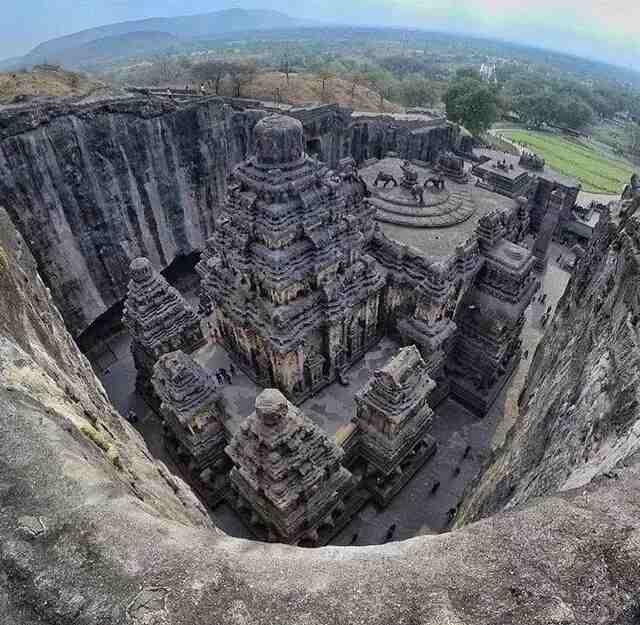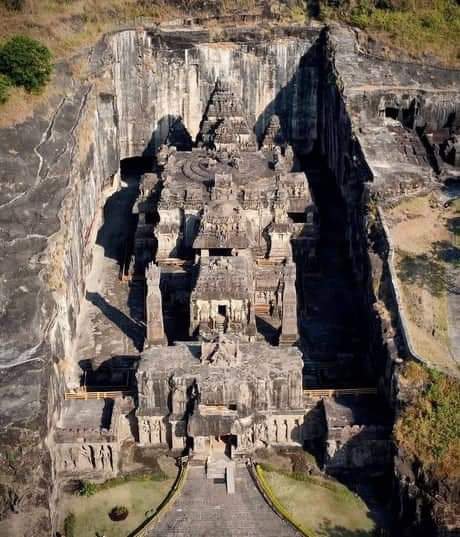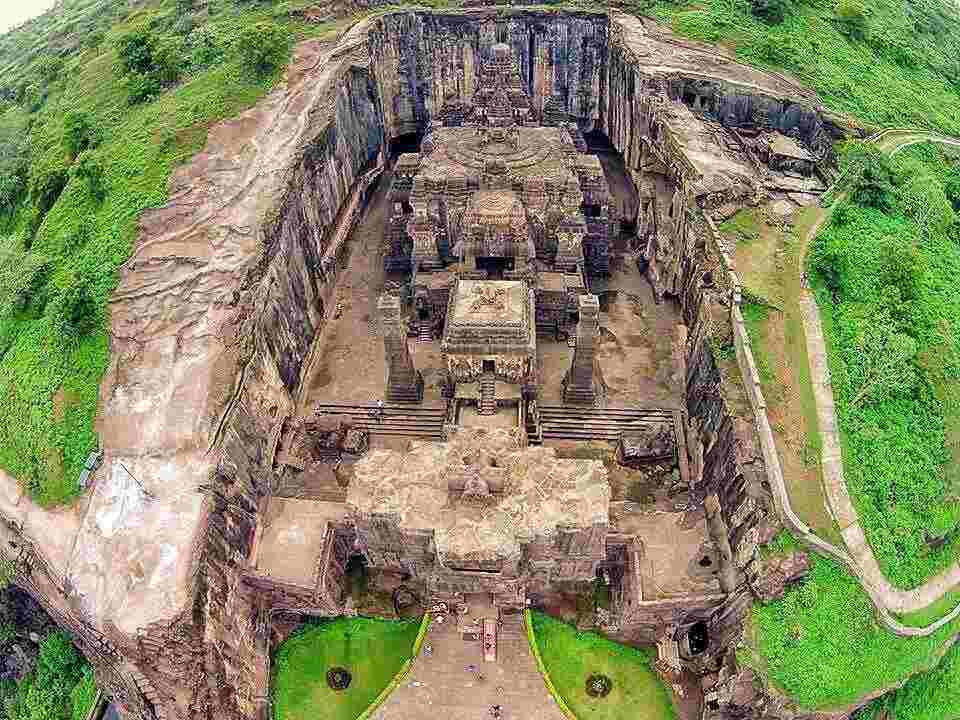Hidden within the rugged terrain of Maharashtra, India, stands the Kailasa Temple, an architectural marvel that has puzzled historians, archaeologists, and engineers for centuries. Carved from a single monolithic rock, this ancient structure is the crowning jewel of the Ellora Caves—a collection of 34 monasteries and temples that represent the epitome of rock-cut architecture.
The Kailasa Temple is not just a temple; it is an enigma that continues to defy conventional understanding of ancient construction techniques. But what is the true story behind this monument, and why does it continue to captivate the modern imagination?
What We Know: Established Facts of the Kailasa Temple
The Kailasa Temple in Ellora is a masterpiece that is believed to have been constructed in the 8th century under the reign of the Rashtrakuta king Krishna I. Its significance is amplified by the sheer scale of its construction; the temple covers an area twice the size of the Parthenon in Athens and was meticulously carved out of a single piece of volcanic basalt rock.
Unlike traditional construction methods that build from the ground up, this temple was excavated from the top down. Historians estimate that approximately 400,000 tons of rock were removed to create this colossal structure—a feat that would have required advanced planning and precision.

Location and Historical Context: The temple is located in the western state of Maharashtra, near the city of Aurangabad. It forms part of the Ellora Caves, a UNESCO World Heritage Site that includes Hindu, Buddhist, and Jain monuments. The Kailasa Temple is dedicated to Lord Shiva and reflects the architectural prowess of its era, combining intricate carvings, grand courtyards, and multi-storied halls.
Architectural Features: The interior of the Kailasa Temple is just as remarkable as its exterior. It features a central shrine with a large Shiva lingam, massive sculptures of deities, animals, and mythological scenes from the Hindu epics. The temple’s most prominent feature is the life-size sculptures of elephants at its base, appearing to hold the entire temple on their backs—a symbolic representation of the mythical Mount Kailasa, the abode of Lord Shiva.
Mysteries Surrounding the Kailasa Temple
Despite the facts known to us, the Kailasa Temple harbors many mysteries. The most pressing question is how such a monumental structure was carved with the tools available in the 8th century. The temple’s precision, symmetry, and scale suggest a level of sophistication that seems out of place in its historical context.
Scholars are perplexed by the temple’s construction timeline; estimates suggest it would have taken less than 18 years to complete. Given the technology of the time, it is unclear how such an undertaking could be accomplished with manual labor alone.
The Construction Conundrum: The lack of documentation or inscriptions providing insight into the temple’s construction only deepens the mystery. Ancient texts like the ‘Ajanta Caves inscriptions’ reference other monuments, but there is an uncanny silence surrounding the creation of the Kailasa Temple. For a deeper dive into its historical context, you may refer to this scholarly article.

How did ancient builders plan and execute a structure that would require such mathematical precision and architectural acumen? Was there a forgotten technique or tool that we have yet to discover?
Theories and Speculation: Unraveling the Mystical Construction
The mysteries surrounding the Kailasa Temple have spurred numerous theories ranging from the plausible to the fantastical. Here are some of the most widely discussed explanations:
1. Advanced Ancient Technology: One theory posits that the ancient builders possessed an advanced form of technology that has since been lost to time. Proponents suggest that this could include laser-like tools or knowledge of anti-gravity principles to move the massive blocks. While there is no archaeological evidence to support these claims, the precision and scale of the temple’s architecture suggest an understanding of engineering principles that were far ahead of their time.
2. Divine Intervention or Extraterrestrial Assistance: Another popular theory is the idea of divine intervention or even extraterrestrial help. Some believe that the temple’s construction was aided by celestial beings or ancient aliens, referencing the fact that many ancient cultures, including those in India, have myths involving gods or beings from the sky. Although intriguing, these theories often lack scientific backing and rely heavily on speculative connections.

3. Human Ingenuity and Workforce Management: A more grounded theory revolves around the effective management of a large workforce. Ancient India had a rich tradition of skilled labor in the fields of stonemasonry and engineering. The Kailasa Temple could have been the result of thousands of workers laboring for years under the direction of master architects. This theory is supported by the presence of similarly massive monuments in other parts of India, such as the Konark Sun Temple.
Frequently Asked Questions (FAQs)
1. What is the mystery of Kailasa Temple?
The mystery of the Kailasa Temple lies in its construction method and timeline, which seem far too advanced for the 8th century. The temple was carved from a single rock, requiring the removal of around 400,000 tons of stone without clear historical records explaining how this was achieved.
2. What is the history of Kailasa Temple?
The Kailasa Temple was built during the reign of the Rashtrakuta king Krishna I in the 8th century and is dedicated to Lord Shiva. It forms part of the Ellora Caves, a UNESCO World Heritage Site in Maharashtra, India.
3. How was the Kailasa Temple built?
The Kailasa Temple was constructed using a unique top-down method, carving out the rock from above rather than building up from the ground. The exact techniques remain unknown, sparking various theories about ancient technologies and methods.
4. When was the Kailasa Temple built?
The Kailasa Temple is believed to have been constructed in the 8th century under the reign of the Rashtrakuta dynasty, specifically during King Krishna I’s rule.
5. Where is the Kailasa Temple located?
The Kailasa Temple is located at the Ellora Caves in Maharashtra, India, near the city of Aurangabad.
The Ongoing Mystery of the Kailasa Temple

The Kailasa Temple remains a compelling enigma that continues to attract attention from researchers and visitors worldwide. While we have a basic understanding of its history and architectural features, the questions about its construction—’how was Kailasa Temple built?’ or ‘when was the Kailasa Temple built?’—remain largely unanswered, much like the mysteries surrounding the Yonaguni Monument Theories. It stands as a testament to human ingenuity, artistic achievement, and possibly, forgotten ancient knowledge.
Until more evidence comes to light, the Kailasa Temple will continue to spark curiosity and inspire wonder. This ancient marvel may indeed hold its secrets close, reminding us that some mysteries, like the Great Pyramid’s Construction Timeline, are meant to endure.
Use of Our Content
⚠️ Content on “Mystery Uncover” is protected under US and International Copyright Laws.
You are free to reuse, republish, and share our content by giving credit to the source as Mystery Uncover with a link to the original material on mysteryuncover.com.






